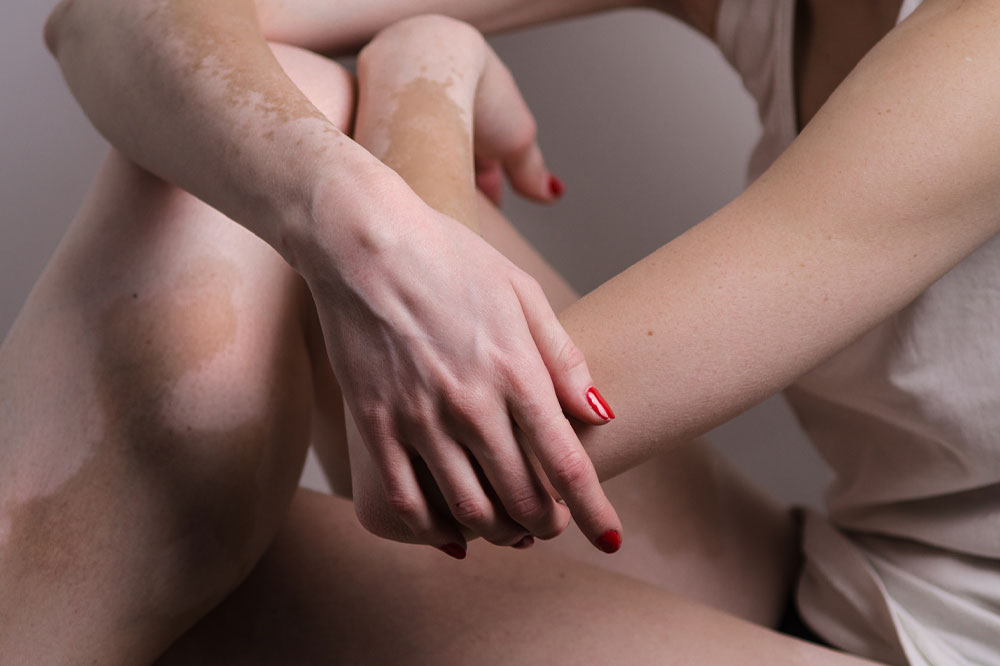Vitiligo – Symptoms, Causes, and Management Options
Vitiligo is a skin condition that has impacted millions of people worldwide. It affects people of all ages and genders. Vitiligo is a chronic skin condition that causes loss of natural pigment of the skin and results in the appearance of light-colored or white spots on arms, legs, and other parts of the body. Although it is not a life-threatening condition, vitiligo can significantly impact a person’s self-esteem, clothing choices, and quality of life.
Symptoms of vitiligo
Vitiligo spots can occur in different shapes and sizes. They may range from small and circular spots to irregular patches that cover several inches of the skin.

Milky patches on the skin
Vitiligo is the appearance of light or white-colored patches or spots on the skin due to loss of skin pigmentation. These light patches or vitiligo spots can occur anywhere on the body. However, they are most commonly seen on the neck, face, arms, legs, and genital region.
Some people show the presence of small vitiligo spots, while others might show the presence of larger patches. These patches can further merge, covering a more significant portion of the body.
Graying hair
People with vitiligo diagnosis can show graying, silvering, or whitening of hair present on the portion of the skin that is losing pigmentation.
Loss of color of mucous membranes
Vitiligo can result in loss of color on and around the mouth, on the lips, in the mouth, and around and inside the nose.
Sunburn
Patches of skin that have lost pigmentation are more sensitive to sunlight, making the skin more prone to sunburn. Conversely, sunburn can further trigger the development and spread of vitiligo.
Itchy patches
When the vitiligo spots are actively spreading, it can cause the patches to itch.
Changes in eye color
If the condition affects the person’s eye, it could cause a change in their eye color. This is a quick change and does not happen over time. In rare cases, a vision change might also occur. People might also experience swelling or inflammation of the eye, also known as uveitis.
Hearing loss
Melanocytes, the cells responsible for the color of the hair, skin, and eyes, can also be found in the inner ear. The body attacks these cells when a patient develops vitiligo. If the body attacks melanocytes in the inner ear, it can result in loss of hearing for the patient.
In addition to physical symptoms, vitiligo can have a significant psychological impact on individuals. Many people diagnosed with vitiligo experience depression, low self-esteem, and anxiety. Certain clothing, social situations, and activities might make them feel self-conscious and isolated.
Causes of vitiligo
Vitiligo is an autoimmune condition where the immune system attacks and destroys melanocytes. However, its exact cause is still unknown. The condition is not prevalent in one particular race or skin color. The condition develops in most patients before they turn 20. Some even develop it when they are still children. In most cases, these children have a relative who has this condition.
Genetics
Changes in the DNA or genetic mutations can also significantly change the functioning of melanocytes, leading to an increased risk of developing vitiligo.
History
If a person has a blood relative that has vitiligo or certain other autoimmune disorders, it can put them at a higher risk than the generalized population. Some melanoma patients undergoing immunotherapy may also be susceptible to developing vitiligo spots.
Environmental triggers
Environmental triggers like toxic chemicals and ultraviolet radiation exposure can lead to changes in the functioning of the melanocytes.
Stress
The pigment produced by a melanocyte cell can change if the person is under consistent and frequent stress. It could be either emotional or physical stress. Change in pigmentation can be seen after an injury.
Treatment for vitiligo
While there is no definite cure for vitiligo, there are treatment options that help improve the overall appearance of vitiligo patches and the patient’s quality of life.
Topical solutions
Creams and ointments are among the most common treatments for vitiligo spots. It promotes repigmentation of the skin while also assisting in the reduction of skin inflammation. However, prolonged use of these products needs to be avoided.
Phototherapy
This procedure involves exposing the affected patches of the skin to light to help bring back some color. Professional-grade lasers or UVB light boxes are used for short periods of time . This helps stimulate melanocytes and increases the pigment in the skin leading to the repigmentation of affected patches. However, patients might require time and several treatment sessions before any significant improvement can be seen.
Depigmentation
This therapy involves the removal or reduction of the patient’s natural skin tone to match the regions affected by vitiligo spots. It uses the compound monobenzone that can be applied to healthy areas of the skin.
Surgery
Melanocyte transplantation or skin grafting might reduce the appearance of vitiligo spots and patches in patients. The procedure requires taking healthy patches of skin from other parts of the body and grafting them onto the affected area.

